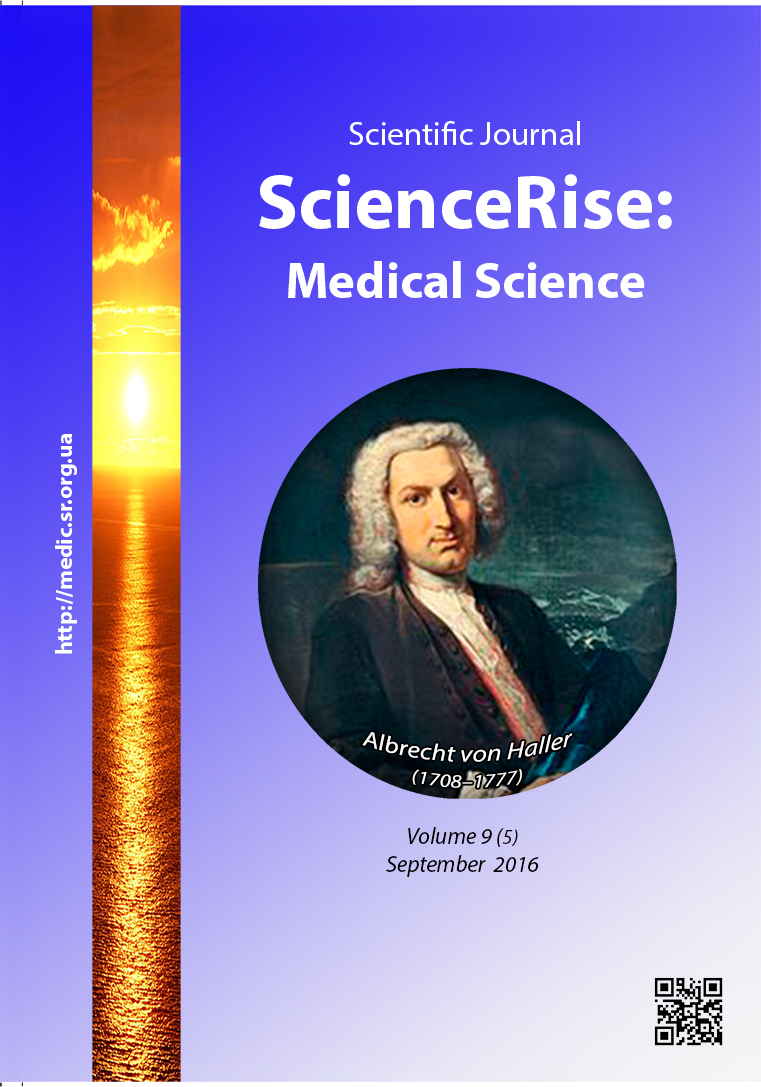The use of electroneurography for differentiation of neuropathic pain component in patients with chronic pain syndromes of the lumbar-sacral localization
DOI:
https://doi.org/10.15587/2519-4798.2016.77939Keywords:
pain in the low part of spine, electroneurography, nonciceptive flexor reflex, neuropathic painAbstract
Aim of research: to study the possibility to use the separate methods of electroneurography, namely nociceptive flexor reflex (NFR) for determination of neuropathic component of pain in patients with the chronic pain syndrome of lumbar-sacral localization.
Materials and methods: 103 patients with the chronic vertebrogenic lumbar-sacral pain syndrome (CVLSPS) and 30 practically healthy persons were examined. According to the results of clinical-neurological examination all patients were divided in groups that corresponded to the first four groups of Classification of spine disease of Quebec special commission (CSDQSC). The determination of state of peripheral neuromotor apparatus was realized using electroneurography of the calf nerve, after that the NFR study was realized.
Results: the speeds of impulse passing on the calf nerve did not differ between patients with CVLSPS and the control group. The reliable decrease of pain threshold (PT) (7,65±1,77), reflex threshold (RT) (9,67±2,0) and ratio of pain threshold/reflex threshold (PT/RT) (0,77±0,11) were revealed in the group of patients with CVLSPS comparing with the group of practically healthy examined persons (8,90±0,94, 10,38±1,05 and 0,86±0,07 respectively). At the analysis of NFR parameters between the groups of patients with CVLSPS the statistically significant differences in PT and RT parameters were not found. PT/RT ratio was statistically reliably lower in IV group (0,73±0,12) comparing with other three groups of patients.
Conclusions: patients with CVLSPS have the reliably lower values of PT and RT and PT/RT ratio comparing with practically healthy persons. PT/RT ratio is the most specific parameter of NFR for differentiation of nociceptive and neuropathic pain components
References
- Breivik, H., Collett, B., Ventafridda, V., Cohen, R., Gallacher, D. (2006). Survey of chronic pain in Europe: Prevalence, impact on daily life, and treatment. European Journal of Pain, 10 (4), 287–287. doi: 10.1016/j.ejpain.2005.06.009
- Freynhagen, R., Baron, R., Tölle, T., Stemmler, E., Gockel, U., Stevens, M., Maier, C. (2006). Screening of neuropathic pain components in patients with chronic back pain associated with nerve root compression: a prospective observational pilot study (MIPORT). Current Medical Research and Opinion, 22 (3), 529–537. doi: 10.1185/030079906x89874
- Freynhagen, R., Baron, R. (2009). The evaluation of neuropathic components in low back pain. Current Pain and Headache Reports, 13 (3), 185–190. doi: 10.1007/s11916-009-0032-y
- Chou, R. (2007). Diagnosis and Treatment of Low Back Pain: A Joint Clinical Practice Guideline from the American College of Physicians and the American Pain Society. Annals of Internal Medicine, 147 (7), 478. doi: 10.7326/0003-4819-147-7-200710020-00006
- Kaki, A., Elyaski, A., Youseif, E. (2005). Identifying Neuropathic Pain Among Patients With Chronic Low-Back Pain: Use of the Leeds Assessment of Neuropathic Symptoms and Signs Pain Scale. Regional Anesthesia and Pain Medicine, 30 (5), 422.e1–422.e9. doi: 10.1016/j.rapm.2005.05.013
- Scholz, J., Mannion, R. J., Hord, D. E., Griffin, R. S., Rawal, B., Zheng, H. et. al. (2009). A Novel Tool for the Assessment of Pain: Validation in Low Back Pain. PLoS Medicine, 6 (4), e1000047. doi: 10.1371/journal.pmed.1000047
- Petersen, T., Olsen, S., Laslett, M., Thorsen, H., Manniche, C., Ekdahl, C., Jacobsen, S. (2004). Inter-tester reliability of a new diagnostic classification system for patients with non-specific low back pain. Australian Journal of Physiotherapy, 50 (2), 85–94. doi: 10.1016/s0004-9514(14)60100-8
- Spitzer, W. O., LeBlanc, F. E., Dupuis, M., Abenhaim, L., Belanger, A. Y., Bloch, R. et. al. (1987). Scientific approach to the assessment and management of activity-related spinal disorders. A monograph for clinicians. Report of the Quebec Task Force on Spinal Disorders. Phyladelphia: Spine, S1–S59.
- Freynhagen, R., Rolke, R., Baron, R., Tölle, T. R., Rutjes, A.-K., Schu, S., Treede, R.-D. (2008). Pseudoradicular and radicular low-back pain – A disease continuum rather than different entities? Answers from quantitative sensory testing. Pain, 135 (1), 65–74. doi: 10.1016/j.pain.2007.05.004
- Skljarevski, V., Ramadan, N. M. (2002). The nociceptive flexion reflex in humans – review article. Pain, 96 (1), 3–8. doi: 10.1016/s0304-3959(02)00018-0
- Danilov, A. B., Vein, A. M. (1996). Notsitseptivniy fleksorniy reflex: metod izucheniya mozgovykh protsessov kontrolya boli [Nociceptive flexion reflex as method of study of cerebral mechanisms of pain control]. Korsakov Journal of Neurology and Psychiatry, 1, 101-107.
- Sandrini, G., Serrao, M., Rossi, P., Romaniello, A., Cruccu, G., Willer, J. C. (2005). The lower limb flexion reflex in humans. Progress in Neurobiology, 77 (6), 353–395. doi: 10.1016/j.pneurobio.2005.11.003
- Atlas, S. J., Deyo, R. A., Patrick, D. L., Convery, K., Keller, R. B., Singer, D. E. (1996). The Quebec Task Force Classification for Spinal Disorders and the Severity, Treatment, and Outcomes of Sciatica and Lumbar Spinal Stenosis. Spine, 21 (24), 2885–2892. doi: 10.1097/00007632-199612150-00020
Downloads
Published
How to Cite
Issue
Section
License
Copyright (c) 2016 Володимир Ігорович Романенко

This work is licensed under a Creative Commons Attribution 4.0 International License.
Our journal abides by the Creative Commons CC BY copyright rights and permissions for open access journals.
Authors, who are published in this journal, agree to the following conditions:
1. The authors reserve the right to authorship of the work and pass the first publication right of this work to the journal under the terms of a Creative Commons CC BY, which allows others to freely distribute the published research with the obligatory reference to the authors of the original work and the first publication of the work in this journal.
2. The authors have the right to conclude separate supplement agreements that relate to non-exclusive work distribution in the form in which it has been published by the journal (for example, to upload the work to the online storage of the journal or publish it as part of a monograph), provided that the reference to the first publication of the work in this journal is included.









